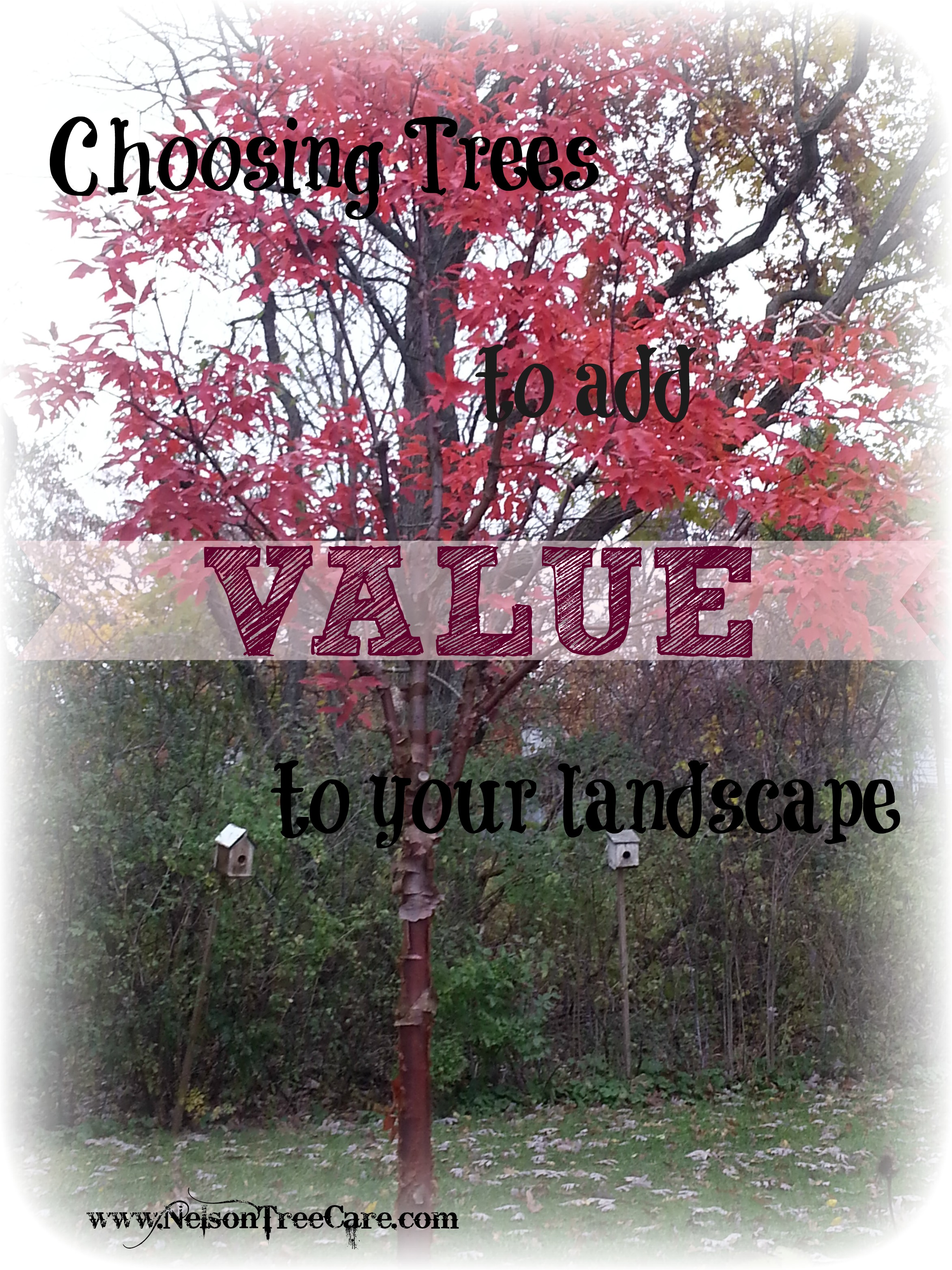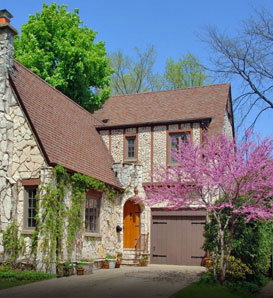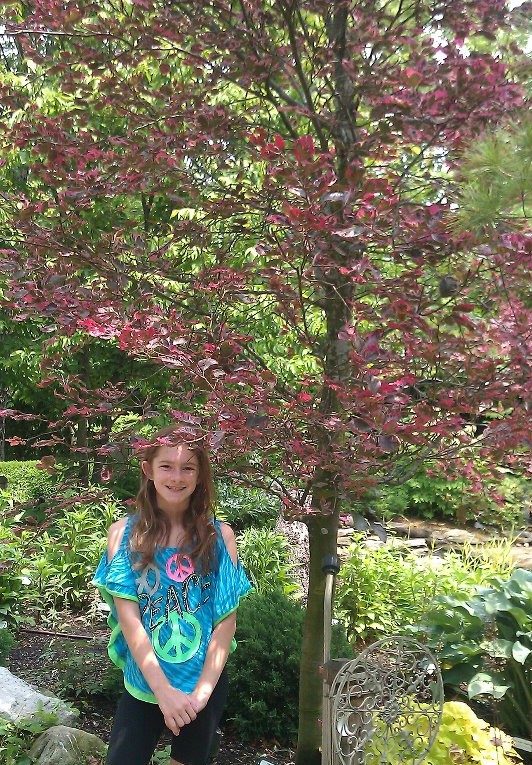
Choosing Trees to Add Value to Your Landscape.
Adding trees to your yard is a surefire way to increase the value of your property. The USDA Forest Service reports that, “Healthy, mature trees add an average of 10 percent to a property’s value.” And, “Landscaping, especially with trees, can increase property values as much as 20 percent.” – Management Information Services/ICMA.
To make sure you get the best value, you will want to plant trees that are of good quality, that will be appealing to look at, or that will give you the best energy value. So what do you plant to make sure you’re adding value to your home? That will depend on a couple of different values. I have outlined them below.
MATURE TREE VALUE
“A mature tree can often have an appraised value of between $1,000 and $10,000.” Council of Tree and Landscape Appraisers
When we think of maturity in a tree, we are often talking hundreds of years, but, that doesn’t mean that as a young tree it does not hold value. The trees that often are the most valued in the landscape as a mature trees are those that are slow growing. According to the University of Purdue, these include White and Bur Oak trees, Baldcypress, and Ginkgo (Male variety) in the Midwestern region. The second most valued trees would include White, Douglas, or Concolor Fir, Sugar Maple, Katsura Tree, Cockspur Hawthorne, American Beech, Kentucky Coffetree (male), Seedless Sweetgum, Hophornbeam, Swamp White Oak, Chinquapin Oak, Redmond Linden, and Canadian Hemlock.
So if your plan is to plant trees that will increase the overall value of your property in the long run, the above list is a good place to start. You will want to work with an arborist or a landscape designer to ensure that you are placing your trees in locations that will be suitable for both the tree(s) and your home as well as other trees on your property. Planting trees too close to one another only leads to competition, and one or both will trees will suffer in functionality and form if this happens.
AESTHETIC TREE VALUE
“In laboratory research, visual exposure to settings with trees has produced significant recovery from stress within five minutes, as indicated by changes in blood pressure and muscle tension.”- Dr. Roger S. Ulrich Texas A&M University
If the goal of your tree installation is to visually enhance your home or landscaping, then you will want to choose good quality trees that are prized for beauty and form. There are a great deal of cultivars today that nurseries are producing to be virtual show pieces in your landscape. When choosing a tree for it’s aesthetic value, be sure to check the label to see what it is susceptible to. Often the most beautiful trees will be susceptible to certain insects, fugal pathogens, or even bacterial infections. According to the University of Illinois Extension, the best trees for ornamental interest are, Crabapples- for scab resistant varieties see here, Amur Chokecherry, Kousa Dogwood, Japanese Lilac Tree, Redbud, Serviceberry, and Tuliptree. You may also want to consider a variety of Maple tree that will produce amazing Fall color such as the Autumn Blaze, Red Sunset, Fall Fiesta or October Glory varieties. Or even a PaperBark Maple- shown in the opening picture which has beautiful bark all year long, as well as red leaves in the Fall. Crimson King Maples and TriColor Beech will offer a beautiful display of leaves throughout the growing season as well!
Once again, make sure that the tree is going to be placed in the best location for that type of tree.
And last,
ENERGY VALUE
“The net cooling effect of a young, healthy tree is equivalent to ten room-size air conditioners operating 20 hours a day.” U.S. Department of Agriculture
“If you plant a tree today on the west side of your home, in 5 years your energy bills should be 3% less. In 15 years the savings will be nearly 12%.”- Dr. E. Greg McPherson, Center for Urban Forest Research
“Trees properly placed around buildings can reduce air conditioning needs by 30 percent and can save 20–50 percent in energy used for heating.”- USDA Forest Service
Sounds Great!! Doesn’t it? So what kind of trees should you plant to make the most of the energy savings? The following list details some trees that can help to improve the overall energy efficiency of your home.. Red Buckeye, American Hornbeam, Maple trees, River Birch, Serviceberry, Catalpa, or Linden. Keep in mind, that properly placed deciduous trees will shade your home in the summer and allow sunlight to get through in the winter to heat your home. You will not want to install your tree right next to the house, however! Again, work with your arborist or landscape designer to decide how far away from your home to plant the tree for the best effect and minimal damage to your home.
Check out this great tool to choose the best location for your trees around your home: Tree Placement Tool
Another energy factor to consider is a wind break. Windbreaks are used to block cold winter winds. Properly placed, they are able to keep your house warmer in the winter months.
When considering a wind break, you will want to use evergreen trees and shrubs. These will provide you with the necessary barrier all year long, not just in the summer when leaves are on deciduous trees. Of course, mixing both evergreen and deciduous trees together will provide greater protection, and add visual appeal as well. Check with your local arboretum to see which evergreens work best in your area. For the midwest, the best shrubs to use are arborvitae- you will want a spreading arborvitae,such as Techny or Dark Green Arborvitae. You can also use trees such as Black Hills Spruce, Douglas, White or Concolor Fir, Canadian Hemlock, and even White Pine. Avoid Austrian Pine or Colorado Blue Spruce trees due to pest and disease issues.
Click on the picture above to be taken to Landscape for Life’s website for more info on energy efficiency.
CLICK HERE FOR THE TREE AND PLANT FINDER FROM MORTON ARBORETUM If you are looking for trees based on this discussion, you can use this link to find the best trees for your purpose and site. You can also type in their search for the trees listed to get more information on each tree.
Hopefully this gives you a good starting point when picking out trees to install based on the value you are looking to get from your trees. If you have any questions or concerns, please feel free to comment, or give us a call to discuss.
References: The Benefits of Trees, ArborDay Foundation; Energy-SavingsTrees from ArborDay.org; LandscapeforLife.Org’s Use Vegetation to increase energy efficiency; University of Purdue Tree Appraisal; University of Illinois Extension Recommended Trees for Northern Illinois






